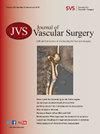Intraoperative position system guided with augmented reality improves the learning curve of endovascular navigation in endovascular-naïve operators
IF 3.9
2区 医学
Q1 PERIPHERAL VASCULAR DISEASE
引用次数: 0
Abstract
Objective
This study aimed to compare the completion of gate cannulation task performed by participants of varying experience using fluoroscopy, the Intraoperative Positioning System (IOPS)—a United States Food and Drug Administration-cleared endovascular navigation system that has been developed to reduce dependence on fluoroscopy—or an investigational augmented reality electromagnetic navigation technology based on IOPS.
Methods
The task consisted in the cannulation of the gate of a GORE Excluder AAA endoprosthesis bifurcated aortic stent graft (W.L. GORE & Associates) deployed into a three-dimensional printed abdominal aortic aneurysm model connected to a 7000 MDX flow pump (Sarns Inc/3M) reproducing physiological conditions. The procedure was performed in a hybrid operating room (GE Allia IGS 7). Each participant performed the cannulation task with fluoroscopy, standard IOPS guidance with flat screen display (IOPS-FS), and the investigational IOPS with augmented reality headset (IOPS-AR), in a randomly assigned order. All participants used the same sensorized guidewire and steerable 6Fr catheter during their three cannulation tasks. A total of 26 participants were classified in three groups of experience: Group 1 (endovascular naïve; n = 13), Group 2 (surgeon in training; n = 12) and Group 3 (one expert surgeon). Primary endpoints included cannulation time and technical success, which was defined as the advancement of the catheter over the guidewire within the main body of the aortic stent graft within a maximum 15-minute cutoff time for each trial.
Results
In group 1, the mean cannulation time was shorter using IOPS-AR vs fluoroscopy (4.3 ± 4.4 vs 7.1 ± 4.9 minutes; P = .04), but not statistically different when comparing IOPS-FS and fluoroscopy (6.3 ± 4.5 vs 7.1 ± 4.9 minutes; P = .63). In group 1, technical success was 77% with fluoroscopy and 92% with both IOPS-FS and IOPS-AR (P = .59). In group 2, although there was no significant difference between cannulation time among the three different endovascular approaches, there was a trend towards shorter cannulation times with IOPS-FS or IOPS-AR as compared with fluoroscopy (mean time of 2.5 ± 0.9, 4.4 ± 4.0, and 5.2 ± 4.5 minutes, respectively). In group 2, technical success was 92% with fluoroscopy and 100% with both IOPS-FS and IOPS-AR (P > .99). The expert vascular surgeon repeated the cannulation task four times for each endovascular approach, with 100% technical success and no difference in mean cannulation time between the imaging modalities (P = .89).
Conclusions
Augmented reality allows for reducing the gate cannulation time as compared with fluoroscopy in participants with no previous exposure to any endovascular procedure. This suggests that augmented reality can be beneficial for individuals early in their career and can mitigate the learning curve. As individuals become experts, their ability to adapt to different endovascular modalities increases, eliminating the learning curve altogether.
以增强现实技术为指导的术中定位系统改善了血管内导航学习曲线,适用于血管内导航新手。
研究目的本研究旨在比较不同经验的参与者使用透视、术中定位系统(IOPS)(一种经 FDA 批准的血管内导航系统,旨在减少对透视的依赖)或基于 IOPS 的研究性增强现实电磁导航技术完成闸门插管任务的情况:任务包括在3D打印的腹主动脉瘤(AAA)模型中插入GORE Excluder AAA内支架分叉主动脉支架移植物(W.L. GORE & Associates, Flagstaff, AZ USA)的闸门,该模型与7000 MDX流量泵(Sarns Inc/3M, Ann Arbor, MI USA)连接,再现了生理条件。手术在混合手术室(GE Allia IGS 7)中进行。每位参与者按照随机分配的顺序,分别在透视、带平面显示器的标准 IOPS 引导(IOPS-FS)和带增强现实耳机的研究型 IOPS 引导(IOPS-AR)下完成插管任务。在三次插管任务中,所有参与者都使用了相同的感应导丝和可转向 6Fr 导管。共有 26 名参与者根据经验被分为三组:第 1 组(血管内手术新手;n = 13)、第 2 组(培训中的外科医生;n = 12)和第 3 组(一名外科医生专家)。主要终点包括插管时间和技术成功率,技术成功率的定义是在每次试验最长 15 分钟的截止时间内将导管推进到主动脉支架移植物主体内的导丝上:在第 1 组中,使用 IOPS-AR 与透视相比,平均插管时间更短(4.3±4.4 分钟 vs 7.1±4.9 分钟;P=.04),但 IOPS-FS 与透视相比,无统计学差异(6.3±4.5 分钟 vs 7.1±4.9 分钟;P=.63)。在第一组中,透视的技术成功率为 77%,IOPS-FS 和 IOPS-AR 的技术成功率均为 92%(P=.59)。在第 2 组中,虽然三种不同的血管内方法的插管时间没有显著差异,但与透视法相比,IOPS-FS 或 IOPS-AR 的插管时间有缩短的趋势(平均时间分别为 2.5±0.9、4.4±4.0 和 5.2±4.5分钟)。在第 2 组中,透视的技术成功率为 92%,而 IOPS-FS 和 IOPS-AR 的技术成功率均为 100%(P>.99)。血管外科医生专家对每种血管内方法重复了四次插管任务,技术成功率为100%,不同成像模式的平均插管时间没有差异(P=.89):结论:与透视法相比,增强现实技术可以缩短之前未接触过任何血管内手术的参与者的插管时间。这表明,增强现实技术对职业生涯初期的人来说是有益的,可以减轻学习曲线。随着个人成为专家,他们适应不同血管内模式的能力也会提高,从而完全消除学习曲线。
本文章由计算机程序翻译,如有差异,请以英文原文为准。
求助全文
约1分钟内获得全文
求助全文
来源期刊
CiteScore
7.70
自引率
18.60%
发文量
1469
审稿时长
54 days
期刊介绍:
Journal of Vascular Surgery ® aims to be the premier international journal of medical, endovascular and surgical care of vascular diseases. It is dedicated to the science and art of vascular surgery and aims to improve the management of patients with vascular diseases by publishing relevant papers that report important medical advances, test new hypotheses, and address current controversies. To acheive this goal, the Journal will publish original clinical and laboratory studies, and reports and papers that comment on the social, economic, ethical, legal, and political factors, which relate to these aims. As the official publication of The Society for Vascular Surgery, the Journal will publish, after peer review, selected papers presented at the annual meeting of this organization and affiliated vascular societies, as well as original articles from members and non-members.

 求助内容:
求助内容: 应助结果提醒方式:
应助结果提醒方式:


